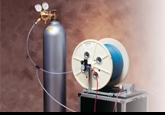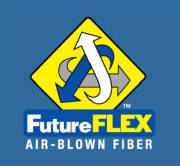
Why Choose An Air Blown Fiber Optic Solution?
An Air Blown Fiber Optic System provides several advantages over a traditional fiber optic distibution system.
An ABF system allows to scale your network, control network capacity, optimize conduit space,
meet your bandwidth requirements quickly, save significant labor and overall project costs, and upgrade your network at the
as emerging technologies become available.
You can scale you network qucikly and easily. Think of this system as "fiber on demand",
install any fiber type where and when you need it quickly. Install fiber optic links in minutes or hours versus days
and weeks of traditional fiber optic installations.
Install fiber easily in hard-to-reach, limited access or secure/sensitive areas.
Install new fiber with disruption to productivity or network operations.
Eliminate guess work of forecasting future needs and wasted capital costs in over or under building the fiber optic infrastructure.
Eliminate risk of install fiber that will not support emerging or future technologies.
Maximize your initial infrastrucutre investment. Fiber bundles can be blown out quickly
and easily and replaced with a new fiber type in virtually minutes — allowing you to reuse the old fiber for another
application in your network.
Control network capacity by optimizing conduit
space. Two 19-tube air-blown fiber cables yield 38 pathways within the same conduit space in which conventional cables
yield only 3 — meaning that you should never again face the cost or need to lay additional conduit. Also,
you know with complete certainty at every moment how much capacity you have left for the future expansion of your network.
Increase the reliability of your network
through FutureFLEX's splice-free, point-to-point infrastructure by eliminating the risk of fiber damage that can occur when
pulling conventional cable and decreasing attenuation for maximum signal integrity.
Eliminate the headaches of forecasting technological
changes and the future requirements of your network so you can pursue the other demands of your job — knowing that with
FutureFLEX you will experience instantaneously quick upgrades, fast project turnaround times, elimination of construction
coordination, less downtime, and lower departmental costs with continuously positive ROI.



